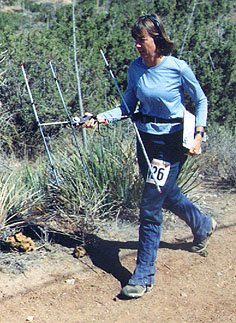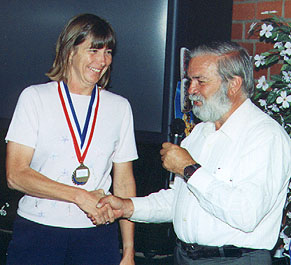 I've been orienteering off and on for quite a few years. Several years ago, I got a ham radio license. I never imagined the two activities would have anything in common. Then I met Marvin Johnston, who told me all about ARDF.
I've been orienteering off and on for quite a few years. Several years ago, I got a ham radio license. I never imagined the two activities would have anything in common. Then I met Marvin Johnston, who told me all about ARDF.
 I've been orienteering off and on for quite a few years. Several years ago, I got a ham radio license. I never imagined the two activities would have anything in common. Then I met Marvin Johnston, who told me all about ARDF.
I've been orienteering off and on for quite a few years. Several years ago, I got a ham radio license. I never imagined the two activities would have anything in common. Then I met Marvin Johnston, who told me all about ARDF.
The concept of radio-orienteering is simple: Instead of marking the control location on a map, the control itself has a radio transmitter sending out signals. The radio-orienteer has a map and a radio receiver, and the hunt is on! I went to several practice sessions in local parks, and found out that most radio-orienteers really know the electronic aspect of the sport, but are less familiar with the map part. It isn't hard to learn how to work a radio receiver, and in fact, a ham radio license isn't even needed to participate. It does take a while to get used to the stares of the weekend park crowd -- with headphones, a big antenna, and an intent look on my face, I must have looked like an alien from outer space!
My first full competition was the 2004 US ARDF Championships. Although the title sounded intimidating, the event was open to everyone, beginners and experts alike. On the first day, the competition used 2-meter radios and was held at Vasquez Rocks. In an ARDF competition, there are five transmitters, but they don't send out continuous radio signals. Instead, the first transmitter sends out distinctive code for one minute, then stops. Then the second transmitter sends out its signal for one minute. The same goes for the rest of the transmitters, and after all five have signaled for one minute each, the cycle repeats.
 At my apointed start time, I turned on my receiver and looked at the map. I was familiar with the Vasquez Rocks map, but all that was marked was the start and finish areas. For the first five minutes, I walked down the road and tried to get a general direction for each of the five transmitters. The signal from #1 seemed loud so I figured it was pretty close, and in the direction of a canyon. Of course the signal only transmits for one minute and goes silent, so it is common to see radio-orienteers running madly for one minute, and then wandering around for the next four. That was me!
At my apointed start time, I turned on my receiver and looked at the map. I was familiar with the Vasquez Rocks map, but all that was marked was the start and finish areas. For the first five minutes, I walked down the road and tried to get a general direction for each of the five transmitters. The signal from #1 seemed loud so I figured it was pretty close, and in the direction of a canyon. Of course the signal only transmits for one minute and goes silent, so it is common to see radio-orienteers running madly for one minute, and then wandering around for the next four. That was me!
The signal led me into the canyon, but after a few cycles I realized that I was actually picking up a reflection of the signal off the canyon walls. I finally went back up to the rim of the canyon, and "lo and behold," found the control up there. I managed to find the other three required controls with only a few mishaps. The big lesson for me was how important the map was. The controls are typically placed not too far from a trail or road, but you still have to know where you are on the map, where the control is likely to be, and what the best route is between the two. My map reading skills served me well.
 On the second day, the competition used 80-meter radios and was held at Mt. Pinos. The 80m receivers are smaller and the direction of the signal can accurately be determined over long distances. Once I started, I spent the first five minutes getting bearings on the five transmitters. Number five seemed close, so I went to that one first, and found it without a problem. I took a second set of bearings on the remaining transmitters, so now I had X's on my map showing approximate locations. It looked like #2 was close, and even though the radio signal was weak, I followed it. Big mistake! I followed the signal through many cycles, and finally found the control hundreds of meters from where I thought it would be. In hindsight, I realized my two bearings were too close together, so I had a "skinny" X for a location.
On the second day, the competition used 80-meter radios and was held at Mt. Pinos. The 80m receivers are smaller and the direction of the signal can accurately be determined over long distances. Once I started, I spent the first five minutes getting bearings on the five transmitters. Number five seemed close, so I went to that one first, and found it without a problem. I took a second set of bearings on the remaining transmitters, so now I had X's on my map showing approximate locations. It looked like #2 was close, and even though the radio signal was weak, I followed it. Big mistake! I followed the signal through many cycles, and finally found the control hundreds of meters from where I thought it would be. In hindsight, I realized my two bearings were too close together, so I had a "skinny" X for a location.
I took bearings on the remaining transmitters, found the remaining two controls I was supposed to find, and made it to the finish within the 2-1/2 hour time limit. However, I was exhausted because I did the course so inefficiently, with way too much uphill.
Now that I survived my first competition, I am ready to do it again! Radio-orienteering is just a different twist on the orienteering I am used to. I am grateful to the fellow radio-orienteers I met during the championships. Although most of these people could run circles around my knowledge of radios, they were all very friendly and helpful, sharing their tips and techniques, and even their equipment. Hopefully we will get more people interested in this sport so we can have more competitions in southern California.
©Copyright 2004 Nancy Pistole. Used by permission. First published in Los Angeles Orienteering, the monthly newsletter of Los Angeles Orienteering Club.
In the photos, top to bottom: Nancy Pistole KF6PAV at the two meter start, the two meter finish, and receiving her second medal at the awards ceremony. Photos ©Copyright 2004 Joe Moell.
 Surfing suggestion: Want more information on the rules, transmitter cycles and age/gender categories? Check the International-Style Foxhunting Comes to the Americas page at this site.
Surfing suggestion: Want more information on the rules, transmitter cycles and age/gender categories? Check the International-Style Foxhunting Comes to the Americas page at this site.
Back to the 2004 USA ARDF Championships photo pages
Back to the Championship Foxhunting News page
 Back to the Homing In home page
Back to the Homing In home page
Links updated 29 December 2006